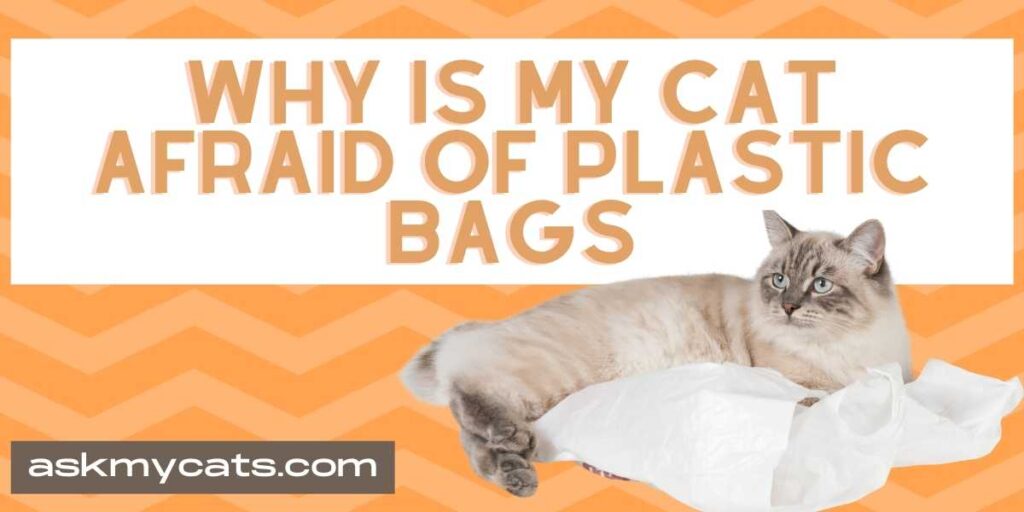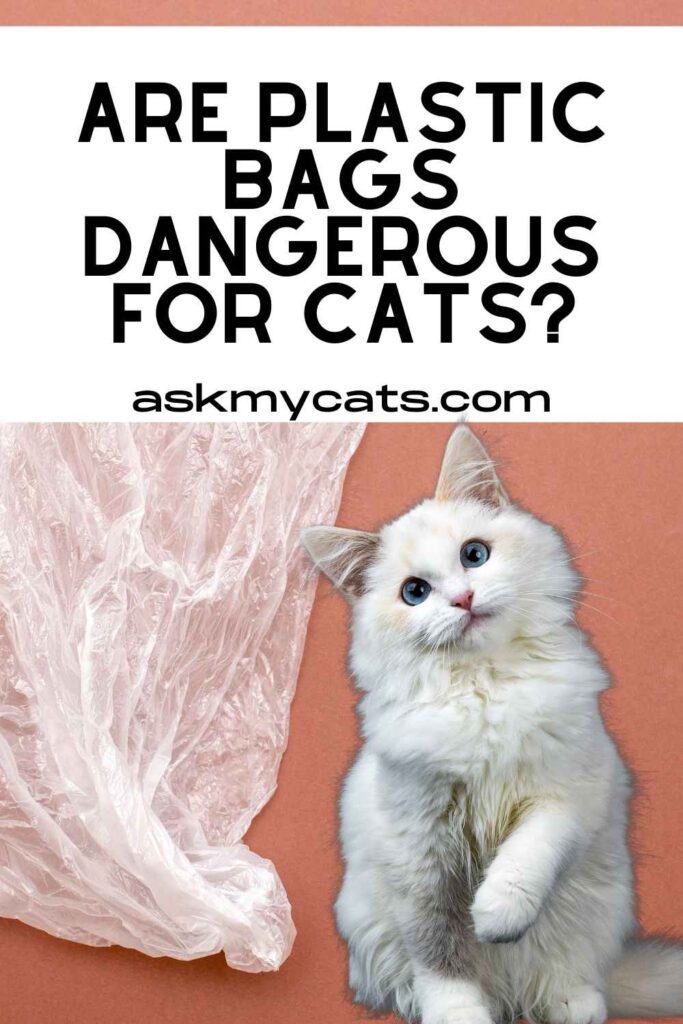How many cat owners have witnessed their feline friend fleeing from the rustling of a waste bag or a plastic grocery bag? What is the root of the problem?
You could be puzzled if your cat is afraid of plastic bags, and you might ask why…
Continue reading for the answers to these questions, as well as much more…


Give Your Cat the Perfect Day
Get the Free Ebook!
Are Cats Scared Of Plastic Bags?
High-pitched noises, such as a flailing plastic garbage can bag, appear to be intuitively frightening to some cats.
Although not all cats are terrified of bags, they do react to them. The crinkling sound attracts their attention, and while some cats may rush inside to play, others appear to despise it and flee as soon as they can.
It all relies on your cat’s personality and past experiences. If your cat is afraid of bags, they may easily grow out of them over time as they learn that the plastic is not a threat (or that the bags may even contain wonderful goodies!).
It’s possible that your cat isn’t as scared of them as you believe. When a cat becomes enthusiastic about anything, it might enter ‘play mode,’ making them appear much more aggressive.
While it appears to us that they dislike whatever it is that they are leaping on and destroying, this is not the truth.
If you’re still convinced they’re scared, treat them as if they had a human fear. Slowly and gently tear some bags apart where they can see them, and let them smell or play with a bit or two.
The key is repetition and patience, and your cat will come to identify the bags with play rather than danger over time.
Why Is My Cat Scared of Plastic Bags?

Other ideas are floating about, but the most common two seem to be: a negative incident with a waste bag in the past, where the sound of a rustling bag triggers terrifying flashbacks, or the sound of a rustling plastic bag.
Your cat may have gotten itself into some difficulty by being in places it shouldn’t have been. Cats have strong memories, and they are clever enough to remain away from danger.
They may have gotten into a bin or been shooed away angrily by someone holding some shopping bags, but cats are smart enough to stay away from danger.
Another hypothesis is that a rustling bag sounds like a snake, and cats are programmed to be scared of snakes. A rustling bag does sound like a hissing snake if you think about it, however, nothing has been established when it comes to cats’ worst nemesis, the plastic bag!
That’s all there is to it. Cats are complex creatures with strong personalities, intelligence, and the ability to remember things. That is why, for generations, they have been one of humanity’s most popular and well-loved pets.
Bags may be frightening to your cat for a variety of reasons. Some people believe it’s only the sound, which is similar to a snake rustling in the bushes, and that it’s a natural survival instinct that this sound makes cats uneasy. It’s also conceivable that it’s just a recollection of them as a kitten.
So, there you have it.
You might also like to read about does cat afraid of ceiling fan
Are Plastic Bags Dangerous for Cats?

Some felines prefer the feel of plastic, which may be used as a quick hiding area.
1. Suffocation
For several reasons, cats and plastic bags are a potentially dangerous mix. Your cat might get the plastic handles wrapped around its neck, cutting off its breathing.
The rigid plastic bags, however, with handles just wide enough for a small head to pass through, can easily choke or suffocate an animal, especially if they panic and can’t get free quickly.
2. Choking
There are poisonous compounds in the plastic that might be hazardous, and their rough tongue causes the plastic to rip often.
They might readily consume small bits of the bag if it breaks, posing a choking hazard. The plastic fragments might induce stomach distress or intestinal obstruction if consumed and could also clog the airway or cause digestive upset.
It’s better to keep the plastic bags out of reach of your cats and instead give them a paper bag. The sound of the paper crunch is equally enticing to cats, and paper bags provide a nice area for a kitten to snuggle inside and hide.
It would not be hazardous if they nibbled off and swallowed parts of the paper. A secure and enjoyable environment for the kitten to play!
Cats and plastic bags are separated using covert diversion techniques. Offer them something more desired if removing the enticing object from her grasp isn’t a possibility. Toys like food puzzles and ball mazes can help to stimulate her senses.
Because cats have a strong hunting drive, plush cat toys that they can chase around the house would be appreciated. Many cats enjoy dog toys, especially strong, long-lasting plush creatures.
Why Do Cats Hate Garbage Trucks?

Cats are unusual animals. They surprise you by acting in the weirdest ways just when you think you know who they are!
One thing is for sure: they all have distinct personalities, and cat owners adore every one of them. However, there are certain similar characteristics among cats, such as their shared dislike and terror of common household things.
We wanted to take a deeper look to see if we could decipher the feline mind and figure out why they despise particular objects!
Noise aversions, or phobias, are frequent in cats and are excessive or unreasonable responses to loud noises such as thunder or fireworks.
It’s natural for a cat to be scared by a loud sound that comes out of nowhere—after all, humans feel the same way when we hear a thunderclap—but dogs with noise phobias are afraid, not startled.
Also, check out Are Cats Scared Of Thunder & Lightning?
Thunderstorms, fireworks, and gunshots are the most typical noise-aversion triggers, but vacuum cleaners, building activities, loud street, or even garbage trucks and traffic sound also send some pets looking for a haven.
Help for Noise-aversive Cats
Because noise aversion can develop in intensity, if you see indicators in your pet, you should treat them as soon as possible. Noise aversion in pets demands patience, just like any other behavior change method. Systematic desensitization and counterconditioning are the cornerstones of noise-aversion treatment.
Systematic desensitization is the practice of gradually reducing a pet’s sensitivity to stimuli (in this example, noise).
Counterconditioning – Creating a new, more desired reaction to a stimulus; for example, noise counterconditioning. While undergoing systematic desensitization, the pet is rewarded for positive behavior (i.e., not responding to noise).
Avoiding the trigger is the most effective strategy to prevent noise aversion in pets, but we can’t always control the weather. The only way to make dogs less afraid of the sound that terrifies them is to utilize rigorous desensitization and counterconditioning techniques.
Begin by buying or downloading a sound file or watching a YouTube video of a loud fireworks show. To avoid frightening your pet, begin by playing the trigger sound gently at first. While the sound is playing, phobic pets may need to start in another room.
While the trigger sound is playing, engage in positive interactions with your cat by throwing a ball, playing with them, or giving them goodies. The ultimate objective is for them to associate the trigger sound with a pleasant experience (like as playing with you or eating rewards).
How Do You Keep a Cat From Being Scared, In General?
Keep an eye out for signs that you’re confusing enthusiasm for worry. Fearful cats will hide their tails between their knees and hiss, and even raise their back hairs.
If there is a definite fear reaction, the most typical therapy is exposure, which is similar to how you would treat a human phobia. Because you have no way of knowing what trauma caused them to be upset in the first place, it’ll mostly be a matter of time. This is typical in rescue cats, but it will pass with time.
Your cat only needs to see and feel protected, and they will ultimately settle down. If the problem is neurological, your veterinarian can recommend you to an animal behavioral specialist, and medication may be a possibility, but give it time – especially if this is a new cat. They will nearly usually relax once they have adjusted to their new surroundings.
Is It True That Adopted Cats Are More Prone to Becoming Scared?
Not nearly as much as you may imagine. While we commonly assume that the person who previously cared for the animal was harsh, this is rarely the case. Poverty or local pet laws are two of the most typical causes for an animal being sent to a shelter to find a new home.
Just be patient and compassionate with your shy cat. Cats are creatures of habit, and with time, they’ll learn to believe that they’ll always be secure while you’re there.
What To Do If Your Cat Is Scared of Plastic Bags?
If your cat is afraid of plastic bags and you’re having difficulties keeping them away, there are a few things you can do to help.
1. Invest a Little Extra Time in Their Disposal
An extra trash can and taking the time to shred up the bags beforehand can help make them less tempting, but it all depends on the cat. When you rip open the bags, some cats will like them even more.
The greatest protection is to make sure your cat never notices them in the first place. A creative diversion, such as catnip or biscuits, can assist in guaranteeing that they aren’t paying attention to you or the bags, giving you some time to dispose of them quickly and discreetly.
2. Replace Plastic Bags
Cats are very observant of the sounds and odors in their surroundings. To begin with, plastic smells strange to them, and when you move the bag to make it rustle and ‘hiss,’ it sounds a lot like a snake to them.
Therefore replacing them with some alternative that is cat and environmentally friendly will be a great way to ensure the safety of our fellow pets and our surroundings.
Using paper bags and jute bags with small and efficient handles can be effective for carrying comestible and also a good play buddy with no rustling noise but a goofy spot to hide in without suffocation.
3. Relieving their Triggers
This is always an option. If something terrifies a cat as much as it terrifies people, they will remember it. The rustle of a bag terrifies most cats because it sounds like something is trapped within or is trying to hurt them, which arouses their hunting instincts.
Therefore, while using a plastic bag, it is easier to make them familiar with the sense of smell and taste, which will bring them closer to understanding the relief of their instincts and you can still have a bag for yourself!
Frequently Asked Questions
What is a pica cat, exactly?
Pica is the desire to consume inedible items. Fabrics, elastics such as hair binders, cardboard, paper, and plastic are the most common objects found in cats. Pica syndrome is more common in kittens and young cats.
What is my cat’s fascination with plastic?
Instinct for predation
This is a completely unreasonable behavior on your cat’s part, and it’s truly just a reaction and instinct. Plastic things may appear to your pet like prey that has to be captured for food, which is why it wants to bite them.
Final Words
Some cats appear to be frightened by high-pitched noises, such as a flapping plastic garbage can bag. It’s conceivable that your cat isn’t as terrified as you think.
Tear some bags apart slowly and carefully where they can see them, and let them sniff or play with them for a while. For a multitude of reasons, bags might be intimidating to your cat.
Noise phobias, or aversions to loud noises, are common in cats and are overly aggressive or irrational responses to loud stimuli.
There are a few things you may do to help your cat that is terrified of plastic bags. Cats are acutely aware of the noises and scents in their environment. A creative distraction, such as catnip or crackers, can help to ensure that they are entertained.
